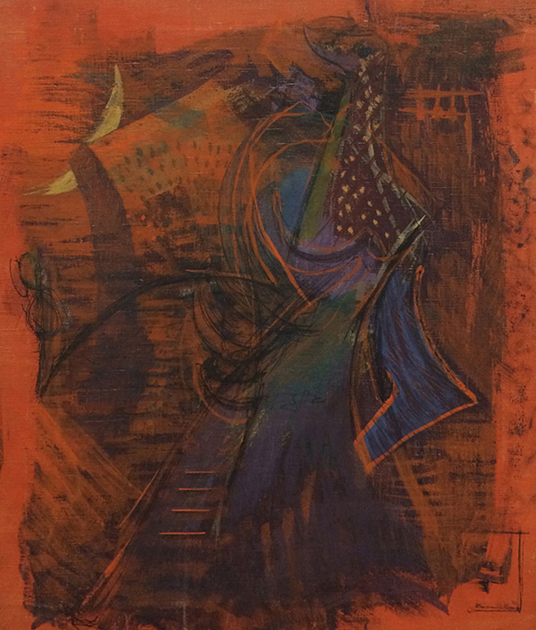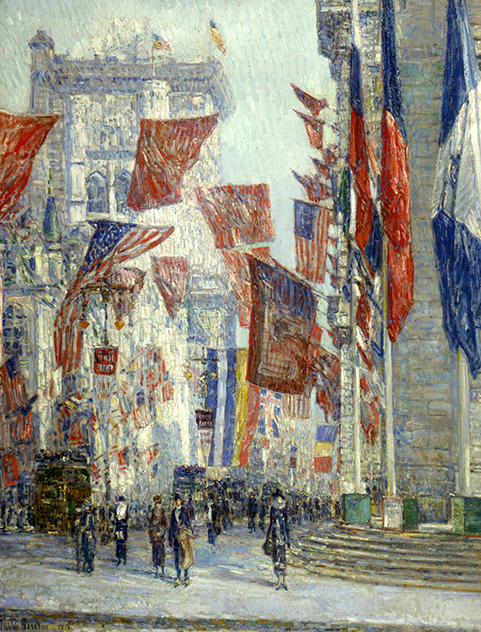.
Stuart Davis, Place des Vosges No. 2, 1928. Oil on canvas, overall: 65.3 x 92.3 cm (25 11/16 x 36 5/16 in.), framed: 80.7 x 107.6 x 9.5 cm (31 3/4 x 42 3/8 x 3 3/4 in.). Herbert F. Johnson Museum of Art, Cornell University, Ithaca, Dr. and Mrs. Milton Lurie Kramer, Class of 1936, Collection, bequest of Helen Kroll Kramer. Art © Estate of Stuart Davis/Licensed by VAGA, New York, NY.
One of the most important American modernists, Stuart Davis blurred distinctions between text and image, high and low art, and abstraction and figuration, crafting a distinct style that continues to influence art being made today. On view at the National Gallery of Art, West Building, from November 20, 2016 through March 5, 2017, Stuart Davis: In Full Swing features some 100 of his most important, visually complex, jazz-inspired compositions, offering a new exploration of his working method.
In Full Swing is the first Davis exhibition at the National Gallery of Art and the first major Davis exhibition anywhere to consistently hang later works side by side with the earlier ones that inspired them. From the paintings of tobacco packages and household objects of the early 1920s to the work left on his easel at the time of his death in 1964, In Full Swing highlights Davis's unique ability to assimilate the imagery of popular culture, the aesthetics of advertising, the lessons of cubism, and the sounds and rhythms of jazz into works that hum with intelligence and energy.
"With a long career that stretched from the early 20th century well into the postwar era, Stuart Davis brought a particularly American accent to international modernism. Davis's works are visually complex, mobilizing bold colors and jagged forms in jangling, jazz-inspired compositions," said Earl A. Powell III, director, National Gallery of Art, Washington. "We are grateful to the many major U.S. museums that lent works, and the Thyssen-Bornemisza Museum in Madrid, which has contributed two rarely seen paintings, as well as to the sponsors, including Altria Group.
"We have supported visual and performing arts for more than 50 years. We are pleased to sponsor the Stuart Davis: In Full Swing exhibition to celebrate a unique voice of mid-20th-century American optimism, which importantly helped launch the era of pop art. We are proud of our long-standing partnership with the Gallery and once again glad to support an exceptional exhibition," said Bruce Gates, Altria's senior vice president of External Affairs.
Stuart Davis: In Full Swing differs from previous exhibitions on the artist not only in its degree of focus but also in its organization. From 1940 on, Davis rarely painted a work that did not make a careful reference to one or more of his earlier compositions—a distinctive aspect of his method.
Along with Alexander Calder, Edward Hopper, and Georgia O'Keeffe, Stuart Davis is one of the four most important American modernists. All had long careers that stretched from the early years of the 20th century well into the post–World War II era. All but Davis have had major exhibitions at the National Gallery of Art: O'Keeffe in 1988, Calder in 1998, and Hopper in 2008.
Starting from decidedly provincial roots as a left-wing illustrator of urban life around New York, and with only a brief sojourn in Paris (1928–1929), Davis brought the lessons of French modernism into American painting between the wars and then emerged in the 1940s with a bold and original manner. In blurring distinctions between text and image, high and low art, and abstraction and figuration, Davis's works have remained vital and continue to influence art being made today. He is often seen as a precursor of both pop art and contemporary abstraction.
Omitting his first decade, when he worked as an illustrator while he tried out various modernist styles, the exhibition focuses on the brilliant sequence of moves that began in 1921 with his paintings of tobacco packages and household objects and ended only with his death in 1964. Highlights of the exhibition include all four of Davis's breakthrough egg-beater paintings of the 1920s, three major murals from the 1930s, and 25 paintings from the 1950s, his greatest decade. Principal lenders include the Brooklyn Museum, the Museum of Modern Art, New York, the Los Angeles County Museum of Art, the Metropolitan Museum of Art, the Hirshhorn Museum and Sculpture Garden, the Smithsonian Museum of American Art, the Whitney Museum of American Art, the Museum of Fine Arts, Boston, and the Phillips Collection.
National Gallery of Art - Stuart Davis - 20.11.2016-05.03.2017










